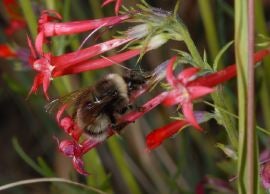
La página que intenta visitar sólo está disponible en inglés. ¡Disculpa!
The page you are about to visit is currently only available in English. Sorry!


Western bumblebee on scarlet gilia [photo copyright David Inouye]
Last week, on what passes for a warm spring afternoon here in the south-central Rockies, I planted the heirloom tomato starts I've nurtured indoors since early March. As I worked, I scanned my kitchen garden for insects.
A red admiral butterfly flew by, its flight path a crazed zig-zag to confuse predators, while a thread-waisted wasp gathered mouthfuls of mud from the surface of the newly watered lettuce bed. Two metallic green bottle flies chased each other over the herbs, and a honeybee burrowed deep into a daffodil flower.
But I was looking for native bees, specifically western bumblebees, Bombus occidentalis to science. You can't miss these big bees with the fat, hairy bodies striped in bold black and yellow, and the lumbering flight.
Bumblebees are what biologists call pollination "generalists," which makes their foraging activities critical to our food supply and the health of our wildlands. As females gather pollen to feed their underground colony, they fertilize the flowers of a wide variety of plants, including wildflowers and many commercial crop plants.
Bumblebees are critical pollinators in part because they emerge earlier in the season and fly at lower light levels than most bees. But it's their unique method of "buzz pollination" that my tomato plants love: A female wraps herself around the flower's reproductive structures, anchors herself with her jaws, and vibrates her wing muscles at a frequency that sounds like middle C to shake pollen from the flower's anthers. Bumblebees' musical pollination is the only effective method for fertilizing flowers like tomatoes, peppers, and cranberries. Since bumblebees discovered my kitchen garden, my yields of tomatoes have increased four-fold.
But these remarkable bees are disappearing at a rate that alarms biologists. The Xerces Society, a leader in conservation of insects and other invertebrates, has started a special campaign to gather information on the status of three species across the country: western, yellow-banded, and the rusty patched bumblebee. So if you see one of these species, let the Xerces Society know at 503-232-6639 or info@xerces.org.
And send the bumblebee in the direction of my tomatoes, please.